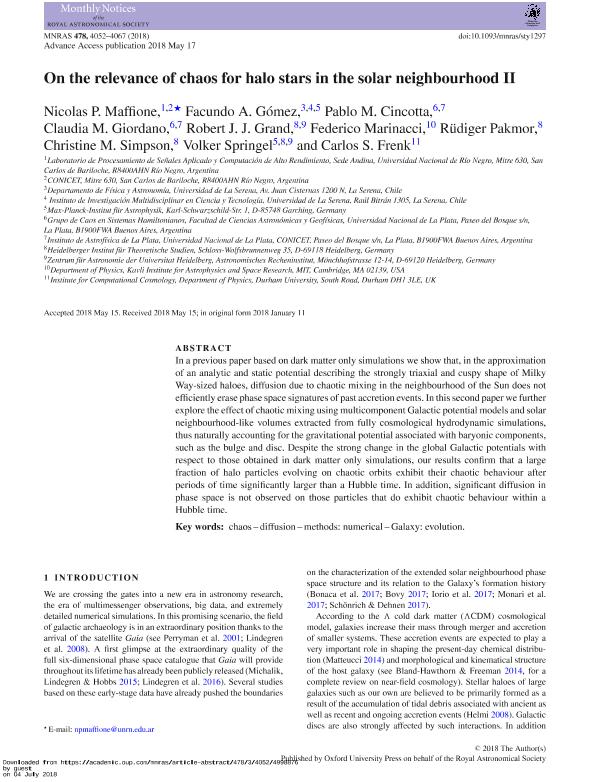Mostrar el registro sencillo del ítem
dc.contributor.author
Maffione, Nicolas Pablo

dc.contributor.author
Gomez Albarracin, Flavia Alejandra

dc.contributor.author
Cincotta, Pablo Miguel

dc.contributor.author
Giordano, Claudia Marcela

dc.contributor.author
Grand, Robert J. J.

dc.contributor.author
Marinacci, Federico

dc.contributor.author
Pakmor, Radiger

dc.contributor.author
Simpson, Christine M.

dc.contributor.author
Springel, Volker
dc.contributor.author
Frenk, C. S.
dc.date.available
2022-09-20T14:43:56Z
dc.date.issued
2018-08-13
dc.identifier.citation
Maffione, Nicolas Pablo; Gomez Albarracin, Flavia Alejandra; Cincotta, Pablo Miguel; Giordano, Claudia Marcela; Grand, Robert J. J.; et al.; On the relevance of chaos for halo stars in the solar neighbourhood II; Wiley Blackwell Publishing, Inc; Monthly Notices of the Royal Astronomical Society; 478; 3; 13-8-2018; 4052-4067
dc.identifier.issn
0035-8711
dc.identifier.uri
http://hdl.handle.net/11336/169591
dc.description.abstract
In a previous paper based on dark matter only simulations we show that, in the approximation of an analytic and static potential describing the strongly triaxial and cuspy shape of Milky Way-sized haloes, diffusion due to chaotic mixing in the neighbourhood of the Sun does not efficiently erase phase space signatures of past accretion events. In this second paper we further explore the effect of chaotic mixing using multicomponent Galactic potential models and solar neighbourhood-like volumes extracted from fully cosmological hydrodynamic simulations, thus naturally accounting for the gravitational potential associated with baryonic components, such as the bulge and disc. Despite the strong change in the global Galactic potentials with respect to those obtained in dark matter only simulations, our results confirm that a large fraction of halo particles evolving on chaotic orbits exhibit their chaotic behaviour after periods of time significantly larger than a Hubble time. In addition, significant diffusion in phase space is not observed on those particles that do exhibit chaotic behaviour within a Hubble time.
dc.format
application/pdf
dc.language.iso
eng
dc.publisher
Wiley Blackwell Publishing, Inc

dc.rights
info:eu-repo/semantics/openAccess
dc.rights.uri
https://creativecommons.org/licenses/by-nc-sa/2.5/ar/
dc.subject
CHAOS
dc.subject
DIFFUSION
dc.subject
GALAXY: EVOLUTION
dc.subject
METHODS: NUMERICAL
dc.subject.classification
Astronomía

dc.subject.classification
Ciencias Físicas

dc.subject.classification
CIENCIAS NATURALES Y EXACTAS

dc.title
On the relevance of chaos for halo stars in the solar neighbourhood II
dc.type
info:eu-repo/semantics/article
dc.type
info:ar-repo/semantics/artículo
dc.type
info:eu-repo/semantics/publishedVersion
dc.date.updated
2021-02-09T18:46:03Z
dc.journal.volume
478
dc.journal.number
3
dc.journal.pagination
4052-4067
dc.journal.pais
Reino Unido

dc.journal.ciudad
Londres
dc.description.fil
Fil: Maffione, Nicolas Pablo. Universidad Nacional de Rio Negro. Sede Andina. Escuela de Producción, Tecnología y Medio Ambiente; Argentina. Consejo Nacional de Investigaciones Científicas y Técnicas; Argentina
dc.description.fil
Fil: Gomez Albarracin, Flavia Alejandra. Gobierno de la República Federal de Alemania. Max Planck Institut für Astrophysik; Alemania. Universidad de La Serena; Chile. Max-Planck-Institut fur Astrophysik; Alemania
dc.description.fil
Fil: Cincotta, Pablo Miguel. Universidad Nacional de La Plata. Facultad de Ciencias Astronómicas y Geofísicas; Argentina. Consejo Nacional de Investigaciones Científicas y Técnicas. Centro Científico Tecnológico Conicet - La Plata. Instituto de Astrofísica La Plata. Universidad Nacional de La Plata. Facultad de Ciencias Astronómicas y Geofísicas. Instituto de Astrofísica La Plata; Argentina
dc.description.fil
Fil: Giordano, Claudia Marcela. Consejo Nacional de Investigaciones Científicas y Técnicas. Centro Científico Tecnológico Conicet - La Plata. Instituto de Astrofísica La Plata. Universidad Nacional de La Plata. Facultad de Ciencias Astronómicas y Geofísicas. Instituto de Astrofísica La Plata; Argentina. Universidad Nacional de La Plata. Facultad de Ciencias Astronómicas y Geofísicas; Argentina
dc.description.fil
Fil: Grand, Robert J. J.. Consejo Nacional de Investigaciones Científicas y Técnicas. Centro Científico Tecnológico Conicet - La Plata. Instituto de Astrofísica La Plata. Universidad Nacional de La Plata. Facultad de Ciencias Astronómicas y Geofísicas. Instituto de Astrofísica La Plata; Argentina
dc.description.fil
Fil: Marinacci, Federico. Consejo Nacional de Investigaciones Científicas y Técnicas. Centro Científico Tecnológico Conicet - La Plata. Instituto de Astrofísica La Plata. Universidad Nacional de La Plata. Facultad de Ciencias Astronómicas y Geofísicas. Instituto de Astrofísica La Plata; Argentina
dc.description.fil
Fil: Pakmor, Radiger. Universidad Nacional de La Plata. Facultad de Ciencias Astronómicas y Geofísicas; Argentina
dc.description.fil
Fil: Simpson, Christine M.. Heidelberger Institut Für Theoretische Studien; Alemania
dc.description.fil
Fil: Springel, Volker. Universitat Heidelberg; Alemania. Max-Planck-Institut fur Astrophysik; Alemania. Heidelberger Institut fur Theoretische Studien; Alemania
dc.description.fil
Fil: Frenk, C. S.. Massachusetts Institute of Technology; Estados Unidos
dc.journal.title
Monthly Notices of the Royal Astronomical Society

dc.relation.alternativeid
info:eu-repo/semantics/altIdentifier/doi/http://dx.doi.org/10.1093/mnras/sty1297
dc.relation.alternativeid
info:eu-repo/semantics/altIdentifier/url/https://academic.oup.com/mnras/article/478/3/4052/4998876?login=true
Archivos asociados
